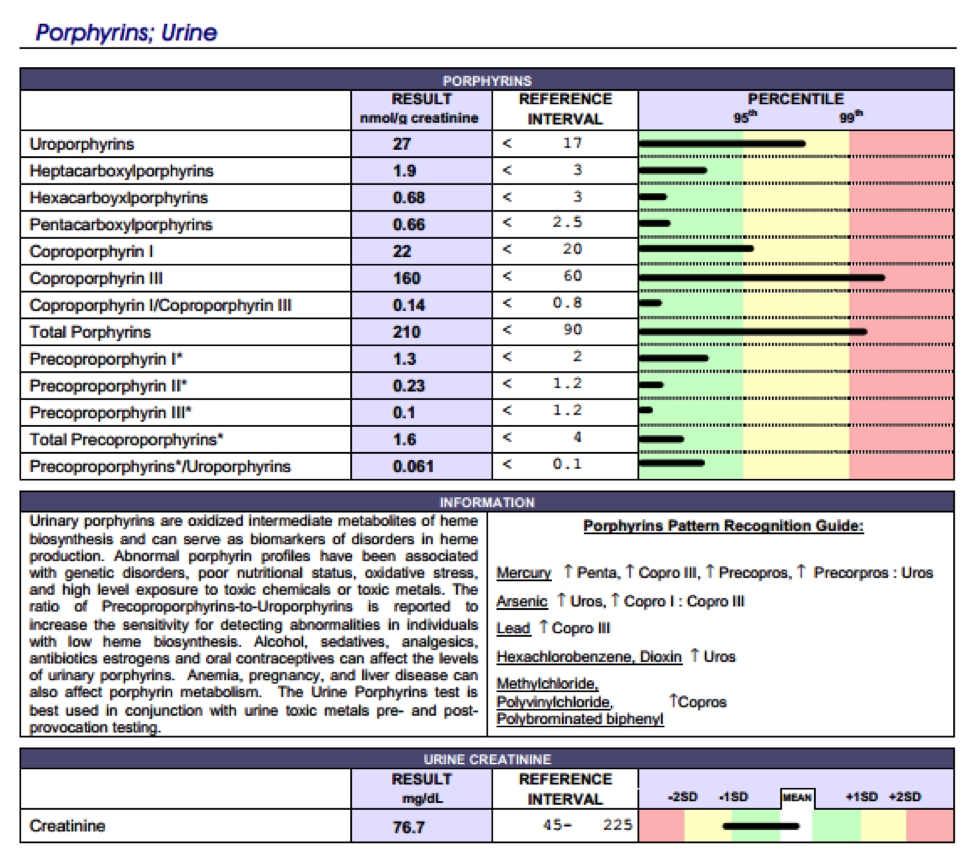
Purpose of running this test:
The Porphryin Test measures a group of organic compounds that play critical functions in your body. The best known porphyrin is heme, which gives the red pigment to your red blood cells. Heme is part of the hemoglobin molecule that has the important function of transporting oxygen in your blood stream. When the pathway for heme synthesis is affected, such as in the presence of high doses of lead, then increased levels of porphyrins can accumulate and be excreted in your urine.
Aside from serving as the oxygen carrying part of your red blood cells, heme also contributes important components to your mitochondrial energy production system. So, proper balance with respect to porphyrins in your body is important. Imbalances in porphyrin levels may reflect oxidative stress, as well as high levels of particular toxins in your body. Specific urinary porphyrins have been associated with very high levels of toxic metals such as mercury, lead and arsenic. In addition, a range of medications and other compounds may affect urine porphyrins, including alcohol, sedatives, analgesics, antibiotics, estrogens, and oral contraceptives. Anemia, pregnancy, and liver disease can also impact porphyrin levels.
While toxic metal profiles can be seen on Hair Elements Test, Urine Toxic Metals Test, and Fecal Metals Test, this test also gives information about imbalances in porphyrins that can explain mitochondrial energy issues, bruising, bleeding, increased sun sensitivity, and potentially a greater need for B complex and zinc.
Lead can block an early step in porphyrin synthesis that creates a compound which competes with GABA. If you are experiencing symptoms that seem to be related to glutamate/GABA balance, it may be due in part to the impact of lead on your porphyrin pathway.
Imbalances in glycine levels also cause an increase in urinary porphyrin.
Porphyrins and pyrroles are different chemical structures. Porphrins are made of up pyrroles, so concerns about kryptopyrrole, pyrrole, pyroluria and HemoPyrrolLactamUria (HPU) are related to issues with porphyrins. This test looks at excess porphyrins as an indicator of toxic metals in your body, but high levels on this test may suggest a need to look more closely at pyrrole levels.
The major pyrrole that is measured on an HPU/pyroluria test is kryptopyrrole. There are a number of labs that perform this test. However, the Environmental Medicine group in the Netherlands has pioneered this work, so I prefer to send urine samples directly to them for assessing kryptopyrroles if needed. Again, the Porphyrin Test is not measuring kryptopyrroles. Rather it is looking at porphyrin levels as indicators of toxic metals in your body. However, since porphyrins are made up of pyrroles, high levels of pyrroles on this test may suggest a need to run a separate urine test looking directly at kryptopyrrole and possible HPU/pyroluria. The link for the test directly from the Netherlands is: http://www.hputest.nl/english.htm.
Kryptopyrroles bind B6 and zinc and can therefore cause deficiencies in these nutrients. HPU or pylouria is essentially a condition of combined B6 and zinc deficiency. Zinc levels can be assessed on a UEE and Hair Elements Test and supported as needed. I do not recommend high dose B6 or P5P support unless it is clearly indicated. B6 can lead to increased levels of taurine on a UAA, deplete intermediates of the methylation cycle, put excessive pressure on the transsulfuration pathway, and increase the need for B12 and molybdenum. This is why administration of high levels of B6 should be used only if there is clear laboratory indication for B6 support. Low level B6 support is recommended and is included in the All in One general vitamin as well as Ultimate B.
| Result | This table contains the rationale behind my suggestions. These suggestions are for your consideration. Defer your choices to your own health care practitioner, as always. |
| pentacarboxyporphyrinogen & coproporphyrinogen III & precoproporphyrin | These porphyrins are reported to reflect excess mercury in your body. Suggestions for consideration are similar to those given when high mercury is seen on toxic metal tests. Aside from a wide range of neurological symptoms, mercury can also cause increased salivation, rashes, and metallic taste in your mouth. It can impact cytochrome P450, and may replace selenium in the T4 to T3 reaction, thus causing thyroid issues.Consider support with Selenium or MetalAway. If more detox is desired, consider DetoxAway. Also, GSH and Indole-3-carbinol may be used. Ultimately, you can support re-myelination with Sphingolin. Work on methylation cycle support to help allow the natural detox of mercury. Also, consider low dose Ion Transport compound to help support detox because it contains Selenocysteine and Wasabi to aid in escorting mercury from your system.
Basic methylation support includes All in One and Phosphatidyl Serine Complex (PS/PE/PC), along with DHA and Methylation Support nucleotide blend. Once lithium is shown to be in balance on a HMT, then consider low dose Methylmate A and Methylmate B, along with extra B12. Be sure lithium is in balance on a HMT. |
| uroporphyrins and coproporphyrin I | These porphyrins are reported to reflect excess arsenic in your body. Suggestions for consideration are similar to those given when high arsenic is seen on toxic metal tests. Methylation cycle function is needed for arsenic excretion. If arsenic is consistently high, consider running a Water Elements Test. Arsenic can bind both to thiol, which is an SH group, as well as to phosphate. It can cause vitamin A deficiency. Symptoms of arsenic toxicity can include white streaked nails, a garlic odor emanating from your body, and/or under pigmentation. Arsenic toxicity may also cause hair loss, problems with folate uptake, or weakness, among other symptoms.At the very least, consider short cut methylation support, support for the pathway that goes from homocysteine to methionine using the BHMT enzyme. All in One, Phosphatidyl Serine Complex (PS/PE/PC), DHA and Methylation Support nucleotide blend all support the short cut. When lithium is in balance, support the long route, the route that uses the MTR and MTRR enzymes. These supports include low dose Methylmate A, Methylmate B, and B12. Also, thiol supports may be useful, such as Selenium, MetalAway, or DetoxAway; low dose Wasabi, low dose Selenocysteine, or low dose Ion Transport compound, which has both Wasabi and Selenocysteine. Broccoli may also be helpful. To support phosphate, use phospholipids such as Phosphatidyl Serine Complex (PS/PE/PC) and Riboflavin-5-Phosphate. |
| coproporphyrin III and in some cases coproporphyrin I | These porphyrins are reported to reflect excess lead in your body. Suggestions for consideration are similar to those given when high lead is seen on toxic metal tests. Lead can deposit in bone and replace calcium there. Lead can also affect ATPase, which reduces the production of this energy molecule. This negatively impacts both sodium and potassium levels, as well as energy production.Lead can bind melatonin, tryptophan, and serotonin. Consider a MAP test and a Neurotransmitter Urine Test to look at energy markers, as well as neurotransmitter levels.
Lead excretion can cause pica, teeth/jaw grinding & aggression. Eating inedible objects may be a sign that lead is being excreted. You may need to consider support to help escort it from your system. Elevated 5-amino levulinic acid (ALA) due to lead toxicity can inhibit Gamma amino butyric acid (GABA), so consider extra GABA if needed. Since lead replaces calcium in bones, consider low dose Bone Support nucleotide blend. Vitamin D and K impact calcium absorption, so add a mineral combination that includes vitamin D and K, such as Cal/Mag/VitD/VitK. Also, for bone health, watch strontium and boron levels. Consider MTR/MTRR/SUOX capsules to support strontium and boron. Also, consider EDTA and MetalAway (or selenium + horsetail grass + low dose EDTA + malic acid) to help escort lead from your system. Also, use additional EDTA in EDTA soap or soak as tolerated. Consider using BactiSolve if you have no shellfish allergies, as another source of EDTA. Consider ATP and/or MitoForce to support ATPase. |
| Uroporphyrin I and III & coproporphyrin III | These porphyrins may reflect excess aluminum in your body. Suggestions for consideration are similar to when aluminum is seen on toxic metal tests. Aluminum can impact the Krebs energy cycle, so consider a Metabolic Analysis Profile (MAP test). Check aluminum l on a HMT. Also, aluminum can negatively impact tetrahydrobiopterin (BH4) formation, which in turn affects dopamine, serotonin and melatonin production. A Neopterin / Biopterin Profile Urine Test can be run to help evaluate BH4 levels.Consider adding MetalAway (or selenium, horsetail grass, low dose EDTA, and malic acid). Also, you can use additional EDTA and EDTA soap or soak as tolerated. If you have no shellfish allergies, consider BactiSolve. Use MTHFR A1298C Liver Support capsules and/or BH4 to help support BH4 levels. Use Vitamin E succinate if succinate levels are low on the MAP test. You can consider a UAA test to look at phenylalanine, tyrosine, and tryptophan levels to see if BH4 needs to be added. |
| Overall elevated porphyrins | Consider MitoForce to support healthy mitochondrial function due to the impact of toxic metals on energy producing cytochromes in your body. Also, consider a direct kryptopyrrole test and assess zinc levels on a HMT and UEE. |
Looking for a particular supplement or word in this chapter?
Enter your search term here to highlight it throughout the page:
Please be patient as it may take a few moments to search through all of the content.
To search the entire site, not just this chapter, please click the magnifying glass icon
next to ‘Resources’ at the top of the page.




